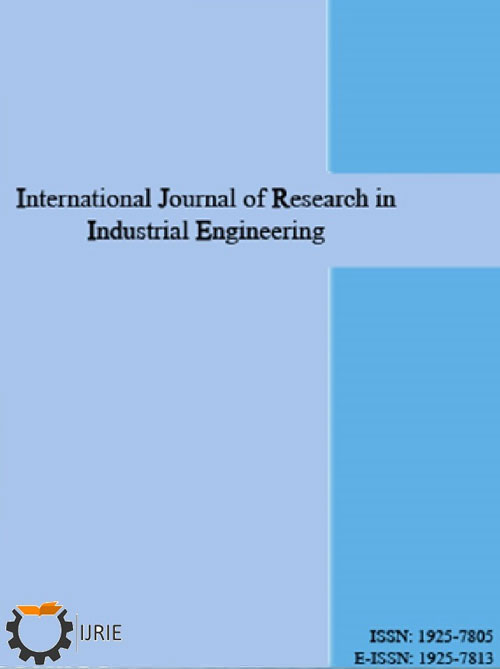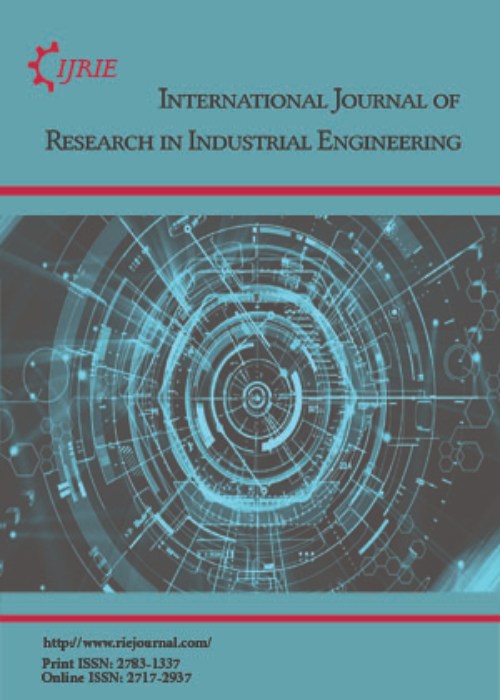فهرست مطالب

International Journal of Research in Industrial Engineering
Volume:9 Issue: 1, Winter 2020
- تاریخ انتشار: 1399/05/19
- تعداد عناوین: 7
-
-
Pages 1-12This paper presents Augmented Monkey Optimization Algorithm (AMOA) applied to solve optimal reactive power problem. Communal behaviour of monkeys has been utilized to model the algorithm. Normally, group monkeys assess the distance from the source to food for foraging behaviour. Local leader renews its most excellent location inside the group, when the food source is not rationalized then the group will start probing in different directions for the food sources. Two most important control parameters are Global Leader Limit (GLlimit) and Local Leader Limit (LLlimit) which give appropriate way to global and local leaders correspondingly. Levy flight has been intermingled in the algorithm to enhance the search ability. Proposed AMOA accelerates the exploitation ability that has been tested in standard IEEE 14, 30, 57,118,300 bus test systems. The simulation results show the projected algorithm reduced the real power loss comprehensively.Keywords: Optimal reactive power, Transmission Loss, Augmented Monkey Optimization Algorithm
-
Pages 13-24Neutrosophic Linear Programming (NLP) issues is presently extensive applications in science and engineering. The primary commitment right now to manage the NLP problem where the coefficients are neutrosophic triangular numbers with blended requirements. The current method [20] are viewed as just imbalance limitations. Notwithstanding, in our paper, we consider both blended requirements and utilize another score function to understand the strategy. To determine the progression of the current method, another strategy is proposed for tackling NLP issues. To check the better outcome, we execute various numerical models.Keywords: neutrosophic linear programming, crisp linear programming, triangular neutrosophic numbers, Score function
-
Pages 25-45In this paper, we aim at developing a model for option pricing to reduce the risks associated with Ethiopian sesame price fluctuations. The White Humera Gondar Sesame Grade 3 (WHGS3) price, which is recorded from 5 November 2010 to 30 March 2018 at Ethiopia Commodity Exchange (ECX) market, is used to analyze the price fluctuation. The nature of log-returns of the price is asymmetric (positively skewed) and exhibits high kurtosis. We used jump diffusion models for modeling and option pricing of sesame price. The method of maximum likelihood is applied to estimate the parameters of the models. We used the Root Mean Square Error (RMSE) to test the goodness of fitting for the two models to the data. This test indicates that the models fit the data well. The techniques of analytical and Monte Carlo simulation are used to find the call option pricing of WHGS3 sesame price. From the results, we concluded that Double Exponential Jump Diffusion (DEJD) model is more efficient than Merton’s model for modeling and option pricing of this sesame price.Keywords: Jump diffusion model, Option pricing, Kurtosis, Skewness, Risk-neutral measure, WHGS3 sesame price
-
Pages 46-64Computer Vision is a field of study that helps to develop techniques to identify images and displays. It has various features like image recognition, object detection and image creation, etc. Object detection is used for face detection, vehicle detection, web images, and safety systems. Its algorithms are Region-based Convolutional Neural Networks (RCNN), Faster-RCNN and You Only Look Once Method (YOLO) that have shown state-of-the-art performance. Of these, YOLO is better in speed compared to accuracy. It has efficient object detection without compromising on performance.Keywords: YOLO, Faster-RCNN, convolutional neural network, COCO
-
Pages 65-76
Selecting the right lean tool is one of the most challenging tasks for decision-makers. This research represents an integration of two methods, Quality Function Deployment (QFD) and TOPSIS, to evaluate and prioritize the lean tools. The aim of this research is to propose an integrated QFD-TOPSIS method for finding and ranking the major wastes on a production floor and also prioritize lean tools for eliminating them. The proposed model consists of House Of Quality (HOQ) to identify major waste signs which transform them into seven wastes. A set of relative weights of the wastes were then determined which were input in the TOPSIS method to prioritize suitable lean tools.
Keywords: Quality Function Deployment, TOPSIS, HOQ, Lean Tools, Waste -
Pages 77-83The aim of this paper is to propose a Six Sigma-DMAIC and food waste hierarchy-based framework that can be successfully implemented by Ethiopian University canteen managers to reduce food waste in a sustainable way. The importance of this research is twofold. First, the Six Sigma-DMAIC methodology is used to evaluate and improve the process to prevent food surplus and waste in the canteen. Second, other waste hierarchy options will be used to mitigate food waste problem in a sustainable way. This has a positive social, environmental, and economic implications.Keywords: Six Sigma, DMAIC, Food Waste Hierarchy, University canteen, Food waste
-
Pages 84-98Nowadays, the recommendation system has made finding the things easy that we need. Movie recommendation systems aim at helping movie enthusiasts by suggesting what movie to watch without having to go through the long process of choosing from a large set of movies which go up to thousands and millions that is time consuming and confusing. In this article, our aim is to reduce the human effort by suggesting movies based on the user’s interests. To handle such problems, we introduced a model combining both content-based and collaborative approach. It will give progressively explicit outcomes compared to different systems that are based on content-based approach. Content-based recommendation systems are constrained to people, these systems don’t prescribe things out of the box, thus limiting your choice to explore more. Hence, we have focused on a system that resolves these issues.Keywords: Movie Recommendation, RATING, genre, recommender system, collaborative filtering


